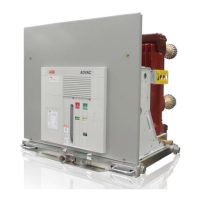11
ABB IB 6.2.15.7-1C
INTERLOCKS:
The ADVAC™ breaker contains a number of interlocks. A description of each interlock follows as encountered during
racking of the breaker into the breaker compartment.
DANGER
MODIFICATION TO INTERLOCKS CAN RESULT IN HAZARDOUS CONDITIONS TO
PERSONNEL AND EQUIPMENT. DO NOT OVERRIDE, BY-PASS OR ADJUST
INTERLOCKS.
CAUTION
THE CLOSING SPRING MAY BE MANUALLY RECHARGED IN THE DISCONNECT AND
WITHDRAWN POSITIONS. VERIFY THAT THE BREAKER IS OPEN AND THE CLOSING
SPRING IS DISCHARGED BEFORE REMOVING THE FRONT COVER.
AUTOMATIC SPRING DISCHARGE (ASD): This maintenance interlock discharges the closing spring and opens the
breaker. Activation of the ASD occurs when withdrawing the locking tabs in the Disconnect position.
P
OSITION INTERLOCKS: The Position Release Lever must be depressed in order to begin racking the breaker in any
direction from any positive position (Disconnect, Test, or Connect). The release lever is blocked from actuation when
the breaker is CLOSED. The ability to close the breaker is blocked unless the breaker is in one of the three positive
positions.
INTERFERENCE BLOCKING: A code plate in the breaker compartment prevents underrated breakers from being
inserted into higher rated compartments. The code plate rating includes continuous current, interrupting current,
close and latch capability and maximum voltage. Breakers with the same or higher code plate rating can be inserted
into a compartment of equal or lower value.
P
OSITIVE POSITION FOR RACKING: The racking mechanism is blocked unless the interlock tabs are fully extended into
the compartment slots.
P
OSITIVE POSITION FOR REMOVAL: The handle release pin prevents withdrawing the breaker from the compartment by
blocking withdrawal of the locking tabs. The handle release pin blocks the handles unless the breaker is in the
Disconnect position.
MECHANISM AND OPERATION

